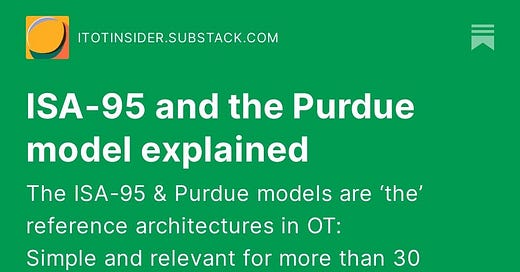ISA-95 and the Purdue model explained
The ISA-95 & Purdue (*) models are ‘the’ reference architectures in OT: Simple and relevant for more than 30 years. You need to understand it to understand OT.
OT has a different perspective than IT on the world. The world of manufacturing isn’t virtual, it’s real, with ‘stuff’, sensors, actuators and control systems. This also brings additional complexity when describing this system. How do you describe an architecture that mixes reactors, sensors, real-time control systems, MES and ERP without getting lost?
The Purdue (*) model solves this problem by organizing systems based on levels of control.
Level 0: The physical process,
Level 1: The sensor/actuators like a pressure transmitter or a motor,
Level 2: Control systems like DCS and SCADA,
Level 3: Manufacturing operations systems like Manufacturing Execution Systems, Process Data Historians & Visualisation, Batch management software etc,
Level 4: Business systems (ERP, Data Lakes…).
This hierarchy was often visualized as a pyramid (Level 0 as the base and Level 4 the top), but we don’t think this is an accurate representation.. A pyramid implies that the world stops after level 4 and that IT only accounts for a small portion of what we do.
Why go for a Standard approach?
NEW! We just launched our ITOT.Academy. Learn the language and architecture of IT and OT to push past “just a POC” in our live online academy.
The key principles and benefits of the Purdue Model include:
Common Language : The key benefit is that regardless of technology and vendor, people understand what a level 2 system means and where it fits in the overall architecture.
Isolation of Levels: Each level has specific responsibilities and communication protocols. We don’t mix up systems that belong to different levels in one group. This increases stability and security.
Developing best practices: by giving things a name and a place it’s possible to develop best practices and ‘rules’. One of those best practices arising from this model is to never ‘skip a level’ as data moves through your network. You don’t connect a motor directly to your ERP. It has to go through several systems and different protocols before it reaches its destination.
The levels explained
Level 0: The Physical Process
Not much special here in terms of Digitalization. This represents the Physical Process (the pipes, the belts, the reactors, the cutting machines, you name it…).
Level 1: Sense & Manipulate
Time scale : milliseconds
This is the first actual playground for OT people: we sense and manipulate the process using intelligent devices. This is where you will find flow meters, motors, level controls, temperature & pressure sensors and so on.
The level of digitalization of these devices depends on their age and the control systems who run at Level 2. In most cases signals are transferred using an analog 4 -20 mA signal. ‘Newer’ technologies like Profibus and Profinet enable to capture much more information with less cables (eg, health information).
Depending on the industry and complexity of your plant, we sometimes find basic control functions here as well. These are programmed into Programmable Logic Controllers (PLCs) and Remote Terminal Units (RTUs).
Level 2: Supervisory Control (Batch/Continuous/Discrete)
Time scale : seconds
This level involves supervisory control and data acquisition (SCADA or DCS) systems. They monitor and control multiple processes and devices within a specific area or facility, providing operators with real-time data, alarms, and control capabilities.
Level 3: Manufacturing Operations Management (MOM)
Time scale: minutes
This level handles production scheduling, order processing, and other higher-level manufacturing processes. It coordinates activities across multiple production lines and helps to optimize manufacturing efficiency. Typical examples of systems here include MES (Manufacturing Execution Systems), site-wide Historians, Laboratory Systems, Warehouse automation and more…
Level 4: Business Network
Time scale : hours-days
At this level, the focus shifts to business operations and enterprise-level planning. It includes functions like inventory management, supply chain optimization, and enterprise resource planning (ERP) systems.
Limitations
The Purdue model has proven itself, but also has some severe limitations. In order to remain relevant it needs to adapt to the current technologies like OT Data Lakes, Cloud and IIoT. Read more about this in Part 2 of this article.
Quick summary for Your next Powerpoint slide:
The Purdue model is a longstanding reference architecture in industrial control systems. The 4+1 levels help the OT world to build secure solutions and have a common terminology.
Level 0: Represents the physical process.
Level 1: Involves sensor/actuators for real-time manipulation.
Level 2: Encompasses control systems like DCS and SCADA.
Level 3: Covers manufacturing operations systems like MES and data historians.
Level 4: Involves business systems like your ERP.
(*) Or more precise: When we talk about the “ISA-95” model, we mean the ANSI/ISA-95.00.01-2010 (IEC 62264-1) Functional Hierarchy Model. When we refer to the “Purdue” model, we mean the Purdue Enterprise Reference Architecture (PERA) model
NEW! We just launched our ITOT.Academy. Learn the language and architecture of IT and OT to push past “just a POC” in our live online academy.






Thanks for the post! I just wonder why you place the batch management software in the Level 3 while S88 identified as Level - 2 in S95? Aveva batch management software consist batch execution(control), scheduling the batch, recipe manager, modelling the batch and also batch historian. Which one of this feature will be an MES?